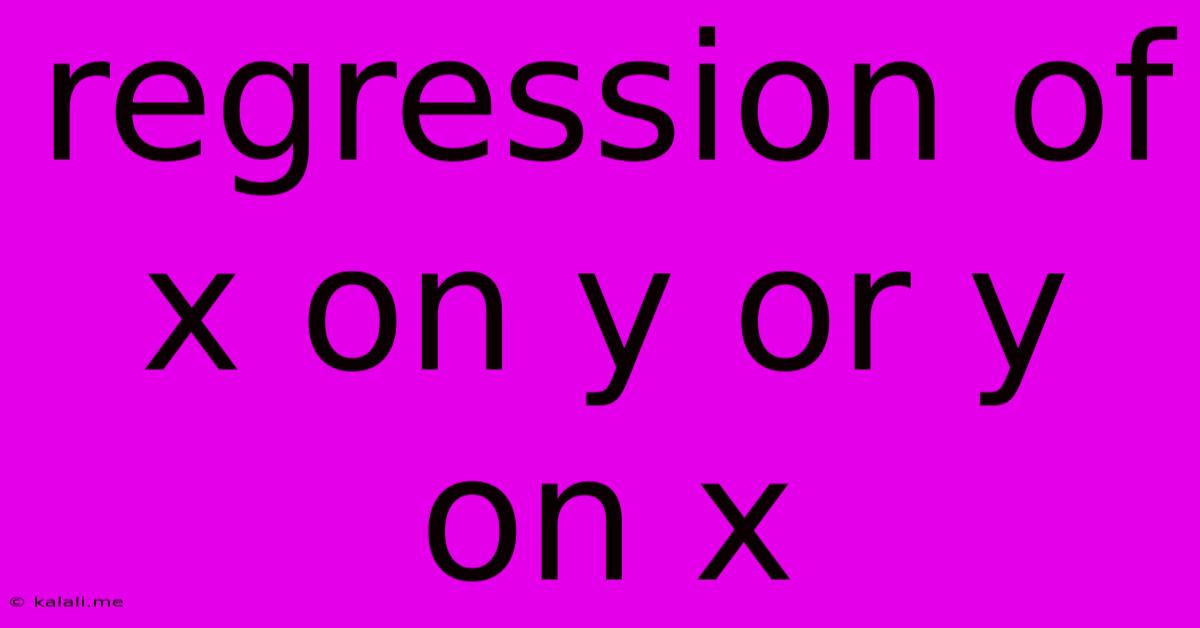Regression Of X On Y Or Y On X
Kalali
May 30, 2025 · 3 min read

Table of Contents
Regression of X on Y or Y on X: Understanding the Difference
Regression analysis is a powerful statistical tool used to model the relationship between a dependent variable and one or more independent variables. A common question that arises, especially for beginners, is the difference between regressing X on Y versus regressing Y on X. While seemingly simple, understanding this distinction is crucial for accurate interpretation and application of regression models. This article will clarify the fundamental differences, highlighting the implications for your analysis.
This article will cover: understanding the roles of dependent and independent variables, the impact of reversing the variables, interpreting the results, and choosing the appropriate regression model. We'll explore how the choice affects the resulting regression line, the coefficients, and the overall interpretation of the relationship between X and Y.
Understanding Dependent and Independent Variables
Before diving into the differences, let's establish the basics. In a regression model, we have:
- Dependent Variable (Y): The variable we are trying to predict or explain. It's the outcome or response variable.
- Independent Variable (X): The variable(s) used to predict the dependent variable. They are also known as predictor or explanatory variables.
When we regress Y on X, we're building a model where X is used to predict Y. The model aims to find the best-fitting line (or hyperplane in multiple regression) that minimizes the error in predicting Y based on X. Conversely, regressing X on Y uses Y to predict X.
The Impact of Reversing Variables: A Simple Example
Consider a scenario where X represents hours studied and Y represents exam scores.
-
Regressing Y on X (Exam scores on hours studied): This model tries to predict exam scores based on the hours studied. The resulting regression line shows how exam scores are expected to change with each additional hour of study. The slope represents the change in exam score per hour studied.
-
Regressing X on Y (Hours studied on exam scores): This model tries to predict the hours studied based on the exam score achieved. This is a very different question! This model doesn't directly address how study time influences exam scores, but rather how exam scores might be related to the time spent studying. The slope here represents the change in hours studied per unit change in exam score.
The crucial point is that these two regressions will generally produce different regression lines, slopes, and R-squared values. They answer different research questions.
Interpreting the Results
The interpretation of the coefficients and R-squared values changes dramatically depending on which variable is the dependent variable. The regression coefficients represent the change in the dependent variable for a one-unit change in the independent variable, holding other variables constant (in multiple regression). The R-squared value indicates the proportion of variance in the dependent variable explained by the independent variable(s).
Therefore, comparing the R-squared values from both regressions doesn't directly tell you which model is "better." The choice depends entirely on the research question and the causal relationship (if any) between X and Y.
Choosing the Appropriate Regression Model
The choice between regressing X on Y or Y on X isn't arbitrary. It depends fundamentally on:
- Causality: If you have a theoretical reason to believe one variable causes the other, the causal variable should be the independent variable. For example, if you believe hours studied directly influence exam scores, you would regress Y (exam scores) on X (hours studied).
- Research Question: What are you trying to predict or explain? Your research question dictates which variable should be dependent.
It's crucial to understand that regression analysis does not inherently imply causality. Even if a strong relationship is found, correlation does not equal causation. Careful consideration of potential confounding factors and the underlying theory is essential.
In conclusion, the decision of whether to regress X on Y or Y on X is not merely a technical detail but a critical consideration that depends entirely on the research question and the nature of the relationship between the variables. Understanding the implications of this choice is vital for correctly interpreting regression results and drawing valid conclusions.
Latest Posts
Latest Posts
-
Linus And Lucy Piano Sheet Music
May 31, 2025
-
My Hot Water Runs Out Quickly
May 31, 2025
-
What Happens If You Put A Battery In Water
May 31, 2025
-
Hack To Get A Discharge Hose To Fit Over Pipe
May 31, 2025
-
Is Joint Compound The Same As Plaster
May 31, 2025
Related Post
Thank you for visiting our website which covers about Regression Of X On Y Or Y On X . We hope the information provided has been useful to you. Feel free to contact us if you have any questions or need further assistance. See you next time and don't miss to bookmark.